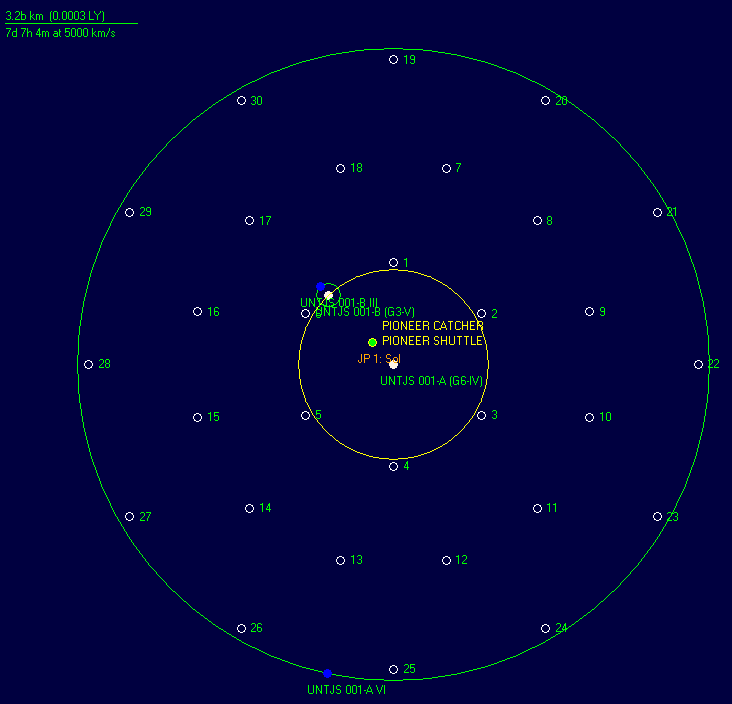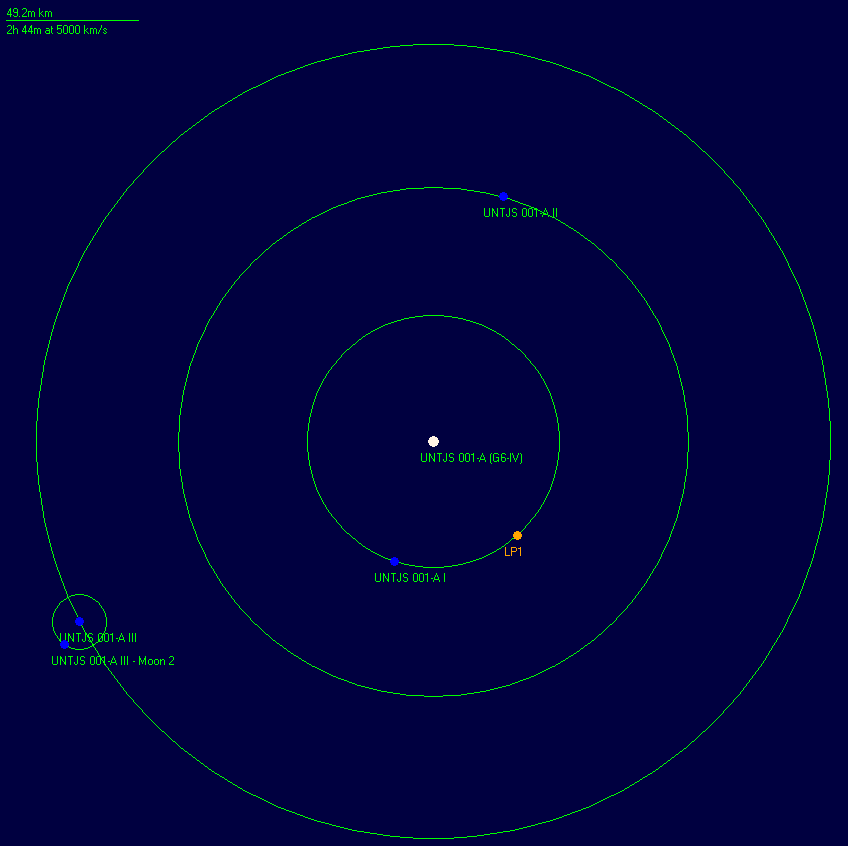Roanoke
Link to Systembodies Raw Viwer
Right Ascension: 7h 14m 9.59s
Declination: 47° 52' 48"
Distance: 307.52 parsecs (1003 light years)
Roanoke, informally Ro or JP3, is a UN claimed binary solar system accessed from Sol by an ungated wormhole near the orbit of pluto.
Roanoke is poor in TNE mineral composition but remarkable as it features a Belnar research outpost on a planet in the inner system, tentatively named "Jamestown". Orbiting this outpost is a derelict alien spaceship, suspected to also be of Belnar origin.
Roanoke was the second solar system to be mentioned in the Belnar Future Museum/Time-capsule after Klondike-Kagayan and published in the Belnar White Paper.
Roanoke is a hub system and has three Jump Points exiting it. Sol, Hakahaka and Uwazi

Geography
Roanoke is an interesting close binary system. A pair of G-class stars whirl about each other at 15 AU (75% of the orbital radius of Uranus), completing one orbit every 37 standard Earth years. The "central" star is a G6 subgiant, rather larger and more luminous that Sol. The companion is nearly a spitting image of the Sun itself, though only 88% as luminous. The geometry of the star system is rather unusual. The primary's inner three planets all huddle tight around the central star, with the third planet being at about the same distance from the star as Earth is from Sol.
The innermost planet of the primary is a Jupiter-sized gas giant less than 50m km from the star. The intense solar radiation at this range causes the planet's atmosphere to "puff" out to extreme heights.
The next planet out, Roanoke-A II is a body about half the diameter of Earth. While the surface gravity is a healthy 40% of Earth standard, the elevated surface temperature of the world (above the boiling point of water) and the lack of atmosphere make it a tough sell to the colonization crowd.
Roanoke-A III is a gas giant about 25% larger than Uranus, with a pair of small, unremarkable moons.
The next orbital body is the companion star and its attendant planets, a configuration long thought to be impossible. The companion star has only two planets.
- The inner body, Roanoke-B I is a third the diameter of the moon, and has a correspondingly weak surface gravity.
- However, the second planet is the real star of the system. Roanoke-B II, "Jamestown", It is a near clone of Earth with respect to diameter (18% greater), density (20% less), surface gravity (6% less), day (4 hours longer), and atmospheric composition and pressure (88% of Earth's). However, as it orbits its star (which is weaker than Sol) at a distance 87% further than Earth does from Sol, the surface is locked in an eternal freeze. Nevertheless, this is a world in another star system in which a properly dressed human could breathe in the open, making it tremendosly valuable.
Next are the primary's outermost two planets. The fourth planet (designated Roanoke-A VI due to a peculiarity with orbital number arrangements i.e., a bug) is a Luna-sized object with no moons of its own.
Finally, the outermost planet, Roanoke-A VII, is another gas giant, even larger than the innermost one. It has some 28 moons, ranging in diameter between 40 and 6000 km. The two largest bodies, moons #9 and #19, are a quarter and half the size of Earth, respectively. However, the intense cold of their remote orbit renders them frozen ice worlds; hardly prime candidates for colonization.
System Schematics
Overview of Roanoke.
Detail of moon system of Roanoke-A VII.
Detail of central system, with JP survey locations, Sol JP, and Roanoke-B location.
Closer detail of central system.
Detail of inner system of Roanoke-A.
Detail of Roanoke-B planetary system.





